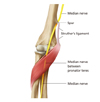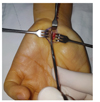References
1. Roh YH, Chung MS, Baek GH, Lee YH, Rhee SH, Gong HS. Incidence of clinically diagnosed and surgically treated carpal tunnel syndrome in Korea. J Hand Surg Am 2010;35:1410–1417.
2. Gong HS, Oh JH, Kim WS, Kim SH, Rhee SH, Baek GH. The effect of dividing muscles superficial to the transverse carpal ligament on carpal tunnel release outcomes. J Hand Surg Am 2011;36:1475–1481.
3. Kim JK, Hann HJ, Kim MJ, Kim JS. The expression of estrogen receptors in the tenosynovium of postmenopausal women with idiopathic carpal tunnel syndrome. J Orthop Res 2010;28:1469–1474.
4. Song CH, Gong HS, Bae KJ, Kim JH, Nam KP, Baek GH. Evaluation of female hormone-related symptoms in women undergoing carpal tunnel release. J Hand Surg Eur Vol 2014;39:155–160.
5. Lee SH, Gong HS, Kim DH, Shin HS, Kim KM, Kim J, Baek GH. Evaluation of vitamin D levels in women with carpal tunnel syndrome. J Hand Surg Eur Vol 2016;41:643–647.
6. Florack TM, Miller RJ, Pellegrini VD, Burton RI, Dunn MG. The prevalence of carpal tunnel syndrome in patients with basal joint arthritis of the thumb. J Hand Surg Am 1992;17:624–630.
7. Shin CH, Paik NJ, Lim JY, Kim TK, Kim KW, Lee JJ, Park JH, Baek GH, Gong HS. Carpal tunnel syndrome and radiographically evident basal joint arthritis of the thumb in elderly Koreans. J Bone Joint Surg Am 2012;94:e1201–e1206.
8. Kim JH, Gong HS, Kim YH, Rhee SH, Kim J, Baek GH. Evaluation of radiographic instability of the trapeziometacarpal joint in women with carpal tunnel syndrome. J Hand Surg Am 2015;40:1298–1302.
9. Yoshii Y, Zhao C, Henderson J, Zhao KD, An KN, Amadio PC. Shear strain and motion of the subsynovial connective tissue and median nerve during single-digit motion. J Hand Surg Am 2009;34:65–73.
10. Kim JH, Gong HS, Lee HJ, Lee YH, Rhee SH, Baek GH. Pre- and post-operative comorbidities in idiopathic carpal tunnel syndrome: cervical arthritis, basal joint arthritis of the thumb, and trigger digit. J Hand Surg Eur Vol 2013;38:50–56.
11. Chung MS, Gong HS, Baek GH. Prevalence of Raynaud's phenomenon in patients with idiopathic carpal tunnel syndrome. J Bone Joint Surg Br 1999;81:1017–1019.
12. Graham B, Peljovich AE, Afra R, Cho MS, Gray R, Stephenson J, Gurman A, MacDermid J, Mlady G, Patel AT, Rempel D, Rozental TD, Salajegheh MK, Keith MW, Jevsevar DS, Shea KG, Bozic KJ, Adams J, Evans JM, Lubahn J, Ray WZ, Spinner R, Thomson G, Shaffer WO, Cummins DS, Murray JN, Mohiuddin M, Mullen K, Shores P, Woznica A, Linskey E, Martinez Y, Sevarino K. The American Academy of Orthopaedic Surgeons evidence-based clinical practice guideline on: management of carpal tunnel syndrome. J Bone Joint Surg Am 2016;98:1750–1754.
13. Cartwright MS, Hobson-Webb LD, Boon AJ, Alter KE, Hunt CH, Flores VH, Werner RA, Shook SJ, Thomas TD, Primack SJ, Walker FO. American Association of Neuromuscular and Electrodiagnostic Medicine. Evidence-based guideline: neuromuscular ultrasound for the diagnosis of carpal tunnel syndrome. Muscle Nerve 2012;46:287–293.
14. Gong HS, Baek GH, Oh JH, Lee YH, Jeon SH, Chung MS. Factors affecting willingness to undergo carpal tunnel release. J Bone Joint Surg Am 2009;91:2130–2136.
15. Gong HS, Huh JK, Lee JH, Kim MB, Chung MS, Baek GH. Patients' preferred and retrospectively perceived levels of involvement during decision-making regarding carpal tunnel release. J Bone Joint Surg Am 2011;93:1527–1533.
16. Nam KP, Gong HS, Bae KJ, Rhee SH, Lee HJ, Baek GH. The effect of patient involvement in surgical decision making for carpal tunnel release on patient-reported outcome. J Hand Surg Am 2014;39:493–498.
17. Lee HJ, Cho YJ, Gong HS, Rhee SH, Park HS, Baek GH. The effect of buffered lidocaine in local anesthesia: a prospective, randomized, double-blind study. J Hand Surg Am 2013;38:971–975.
18. Kwon YE, Gong HS, Shin HS, Lee HR, Kim KH, Baek GH. Evaluation of carpal arch widening and outcomes after carpal tunnel release. J Hand Surg Am 2017;42:113–117.
19. Gong HS, Oh JH, Bin SW, Kim WS, Chung MS, Baek GH. Clinical features influencing the patient-based outcome after carpal tunnel release. J Hand Surg Am 2008;33:1512–1517.
20. Kim JH, Gong HS, Cho HE, Park JW, Kim J, Baek GH. Evaluation of factors associated with night pain in women undergoing carpal tunnel release. J Hand Surg Asian Pac Vol 2016;21:54–58.
21. Roh YH, Lee BK, Noh JH, Oh JH, Gong HS, Baek GH. Effects of metabolic syndrome on the outcome of carpal tunnel release: a matched case-control study. J Hand Surg Am 2015;40:1303–1309.
22. Park JW, Gong HS, Rhee SH, Kim J, Lee YH, Baek GH. The effect of psychological factors on the outcomes of carpal tunnel release: a systematic review. J Hand Surg Asian Pac Vol 2017;22:131–137.
23. Ulrich D, Piatkowski A, Pallua N. Anterior interosseous nerve syndrome: retrospective analysis of 14 patients. Arch Orthop Trauma Surg 2011;131:1561–1565.
24. Wong L, Dellon AL. Brachial neuritis presenting as anterior interosseous nerve compression: implications for diagnosis and treatment: a case report. J Hand Surg Am 1997;22:536–539.
25. Rodner CM, Tinsley BA, O'Malley MP. Pronator syndrome and anterior interosseous nerve syndrome. J Am Acad Orthop Surg 2013;21:268–275.
26. Hussey AJ, O'Brien CP, Regan PJ. Parsonage-turner syndrome-case report and literature review. Hand (N Y) 2007;2:218–221.
27. Nzeako OJ, Tahmassebi R. Idiopathic anterior interosseous nerve dysfunction. J Hand Surg Am 2015;40:2277–2278.
28. Seki M, Nakamura H, Kono H. Neurolysis is not required for young patients with a spontaneous palsy of the anterior interosseous nerve: retrospective analysis of cases managed non-operatively. J Bone Joint Surg Br 2006;88:1606–1609.
29. Koo JT, Szabo RM. Compression neuropathies of the median nerve. J Am Soc Surg Hand 2004;4:156–175.
30. Nagano A, Shibata K, Tokimura H, Yamamoto S, Tajiri Y. Spontaneous anterior interosseous nerve palsy with hourglass-like fascicular constriction within the main trunk of the median nerve. J Hand Surg Am 1996;21:266–270.
31. Seyffarth H. Primary myoses in the M: pronator teres as cause of lesion of the N. medianus (the pronator syndrome). Acta Psychiatr Neurol Scand Suppl 1951;74:251–254.
32. Mujadzic M, Papanicolaou G, Young H, Tsai TM. Simultaneous surgical release of ipsilateral pronator teres and carpal tunnel syndromes. Plast Reconstr Surg 2007;119:2141–2147.
33. Hagert E. Clinical diagnosis and wide-awake surgical treatment of proximal median nerve entrapment at the elbow: a prospective study. Hand (N Y) 2013;8:41–46.
34. Hsiao CW, Shih JT, Hung ST. Concurrent carpal tunnel syndrome and pronator syndrome: a retrospective study of 21 cases. Orthop Traumatol Surg Res 2017;103:101–103.
35. Strohl AB, Zelouf DS. Ulnar tunnel syndrome, radial tunnel syndrome, anterior interosseous nerve syndrome, and pronator syndrome. J Am Acad Orthop Surg 2017;25:e1–e10.



